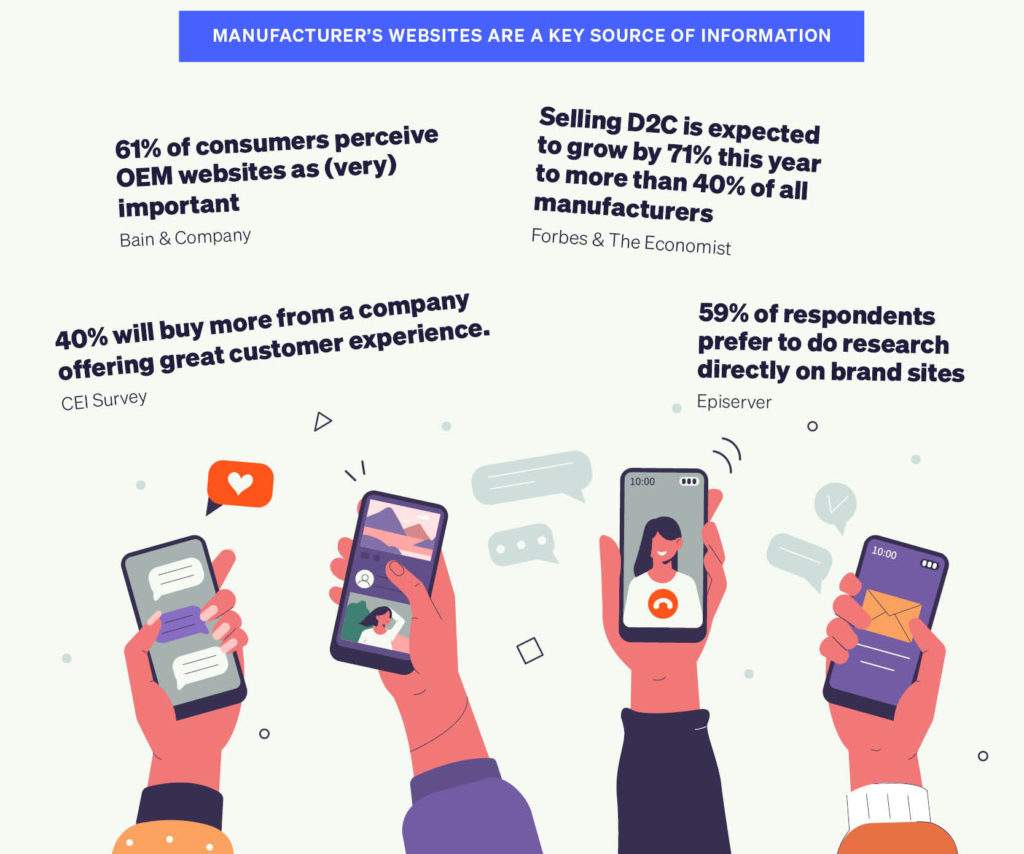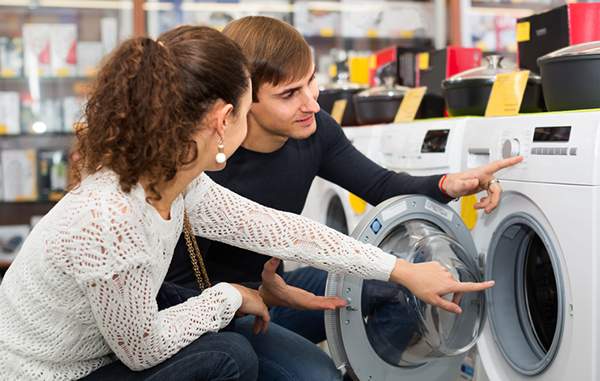
D2C eCommerce: Finding the Right Solution For You
If you’re considering going direct to consumer (D2C), this fact sheet will help you decide which D2C solution is the right fit for you.

It’s clear that today’s consumers are demanding better customer experiences and companies, of all shapes and sizes, are fighting to
deliver direct, one-to-one, experiences that exceed expectations.
Beyond the desire to drive more direct sales, what’s in it for manufacturers and B2B businesses?
Direct-to-consumer (D2C) eCommerce is a way for manufacturers and B2B businesses to take matters into their own hands. Not only is it a way of opening up new sales avenues to grow profits, build customer insight and consequently gain a competitive edge.
In a nutshell, D2C eCommerce gives home appliance manufacturers:
In a recent survey from Episerver, we see a rising trend for consumers spending directly with manufacturers, “59% of respondents prefer to do research directly on brand sites” and “55% want to buy from brands directly.” As brands and manufacturers become more comfortable with selling direct, this trend will only grow.
Direct-to-Consumer eCommerce means owning the entire customer relationship. It gives manufacturers the ability to leverage additional consumer insights that come with it. To create unique, personalized online engagement, better fulfillment and returns experiences.
Not only does a D2C channel help to drive more direct sales, but it provides an opportunity to create recurring revenue streams – be it through subscriptions, new product launches or annual repair services for example. These brand-led tactics provide much better brand loyalty and lifelong customers than otherwise possible through a traditional, retail model.
One of the biggest barriers we find when working with manufacturers
/ B2B brands is the fear that this D2C transition will jeopardise their partner
relationships. Will their partners see this shift as a threat and consider them new competition – dropping them from the shelves altogether?
We’ve found that offering an exclusive range or bundles to your retail partners, whilst selling the ‘basic’ product on your own D2C channel (or vice versa) may be the best way to achieve the best of both worlds.
There are plenty of approaches you can take depending on how risk-adverse or aggressive you’d like to be. If you’re considering shifting to a D2C model but aren’t sure where to start. Then get in touch for a free D2C strategy session with our team.
One of the major issues is that many pure-play start-ups have the benefit of agility on their side. Not shackled by the baggage of legacy systems, processes and operations, or by leadership teams who insist on tradition or “our way of doing things”, these newer businesses can change strategic direction on a whim, and capitalise on new opportunities well before the competition.
The D2C concept is nothing new, and is an area most consumer goods manufacturers, B2B businesses and wholesalers have been experimenting with for some time, but many are recognising the need to step up, or fall behind. The truth is your future survival may well depend on it. We’re already seeing established manufacturers being challenged and usurped by D2C start-ups able to offer a more engaging customer experience.
Setting up an eCommerce platform becomes more complicated the broader your product range is.
Selling D2C or B2C differs from B2B in that consumers don’t always have a specific model number or goal in mind when researching online.
Consumers, no-matter how tech savvy, can find it overwhelming when viewing a large volume of appliance models and features on offer. Offering too much choice can be overwhelming and can adversely affect your conversion rate.
Tip #1 – Simplify the number of products and SKU’s you have available online, at least initially. Instead, focus your efforts on making your product portfolio as easy to navigate and filter as possible.
If you’re a manufacturer that has historically sold thousands of coffee machines in bulk to retailers, selling thousands of small applianes to individuals will need a completely different set of systems and processes to cope with the complexity of B2B, B2B2C and B2C. Not only do you need to consider a new business model but the logistics to fulfil these orders.
Tip #2 – Aim to have a clear and consistent strategy around who your consumer is and the “consumer journey” that you are looking to create. It’s vital that you implement an end-to-end eCommerce solution that can support every segment of your business. One solution that covers eCommerce, order management and systems integration to connect your CRM, payment processing and logistics.
The organisations that we see winning in the D2C market are truly obsessive around consumer-centricity. Make sure this runs through every single consumer touch point from the online website through to the delivery, installation services and the removal of large appliances. Every consumer touch point is key and quite often it’s the last mile delivery and installation process that the customer remembers!

Appliance and electronic orders are 2.6x larger than a typical eCommerce transaction ($416 vs $159) – Adobe Dec 2019.
Given the high-value nature of home appliances and electricals. Many consumers will understandably take a long time to research and compare products before pressing the “Buy” button.
Expensive products require multiple visits which will drive down conversion. In fact, consumer Electronic conversions are typically half the average (1.4% vs 3%). To instil confidence – make sure you cover the basics – from good product photography, model specifications, to customer reviews.
But remember nobody knows your products like you do.
Tip #3 – Work to your strengths and bridge the retail gap by providing what your retail partners can’t. In-depth product knowledge and expertise. This could be through videos, blogs, reviews or even web chat – for advice and guidance – or perhaps comparison engines or filters.
Brands like Dyson have decided to create immersive, brand experiences on their website but still enable “ease of purchase” through a stylish website with fantastic online support.
The underlying eCommerce and Marketing technology you choose should be able to intertwine content and commerce to drive business results online and help deliver a friction-free customer experience. Home appliance and electronics brands that provide shopping experiences that go beyond mere transaction will be the ones that will thrive in 2021 and beyond.
Repairs and spare parts represent a large after-sales opportunity for appliance manufacturers.
In fact, more than 45% of consumers are willing to pay a premium price for an appliance if it includes additional services such as same-day repair.
Tip #4 – Differentiate your online and retail offering with value added services such as repairs, spares and maintenance packages. Value-added services such as these are a great way to increase customer satisfaction, revenue and loyalty.
One of the key reason’s companies look to adopt a D2C model is data. The engagement they can be cultivated before, during and after the purchase is incredibly advantageous. By adopting a D2C channel, you should know when a printer is going to run out of ink… or when a consumer’s current washing machine is in need of maintenance… or when a dryer is ready to be replaced. This data can be used for lucrative cross-sell and up-sell marketing.
Tip #5 – Make sure you on-board customers after their initial purchase and in the first few weeks of using an appliance and
follow up with useful tips and advice to nurture those long-term relationships.
Once your customers are on-board, surprise them with digital experiences that add value. An ingenious example from Electrolux’s Vintec, a maker of temperature-controlled wine cabinets, recently launched Oeno.
Oeno is a virtual wine cellar management app that keeps track of a customer’s wines and provides sommelier-style advice on the best time to open bottles, serving temperatures and wine pairing advice. It can also order wine and restock automatically. These connected-appliance ecosystems are a great way to build value and ‘lock-in’ consumer loyalty.
Granted, not all appliance manufacturers can invest in grand, innovative ideas such as these!
If you’re a kitchen or home appliance brand, new digital services could be simple interactive recipes, step-by-step cooking guides or online courses, all designed to engage users.
The home appliance and white goods industry is facing rapid transformation, particularly as the pandemic accelerates the shift to online sales. Manufacturers that take advantage of the treasure trove of information about their customers and connect with them before, during and after a sale will be the ones that survive, and thrive, in the years to come.
Check back soon when we’ll share our “D2C Maturity Guide: Are you really ready?”. We will outline things to consider when making the move from B2B to B2C or D2C. A practical checklist that covers everything you need to consider before going direct – from people, processes and tech.
Considering going direct-to-consumer but not sure where to start?
Simply fill in the form below for a free 2-hour session
with one of our consultants. *Limited to the first 5 enquiries.

If you’re considering going direct to consumer (D2C), this fact sheet will help you decide which D2C solution is the right fit for you.

If you’re considering going direct to consumer (D2C), this checklist will help to ensure that you’re doing everything you can to make your sales strategy as effective as it can be.

The current COVID-19 crisis has turned D2C routes to market from an opportunity, to a lifeline for many businesses. Take a look at our infographic to find out why.